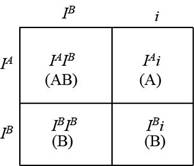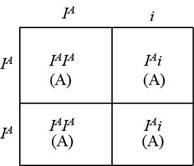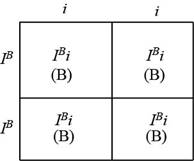
Concept explainers
To determine:
Which baby belongs to which couple by using the given information?
Concept introduction:
The ABO blood group is determined by three alleles of gene I:
If gene I encodes for both molecule A and B, it give rise to blood group type AB (genotype
Explanation of Solution
Tabular representation:

Table 1: Cross between father with genotype

Table 2: Cross between father with genotype

Table 3: Cross between father and mother with genotype

Table 4: Cross between father and mother with genotype

Table 5: Cross between one parent with genotype

Table 6: Cross between father with genotype ii and mother with genotype

Table 7: Cross between father with genotype ii and mother with genotype
Couple 1: Father with B blood type (genotype
If the father has genotype
If the father has genotype
Thus, couple 1 could produce children with blood type A, B or AB.
Couple 2: Father have blood type A and mother have blood type A. Both could have genotypes
If both father and mother have genotype
If both father and mother have genotype
If one parent have genotype
Thus, couple 2 could produce children with blood type A, or O.
Couple 3: Father with blood type O (genotype ii) and mother with blood type B (genotype
If father has genotype ii and mother has genotype
If father has genotype ii and mother has genotype
Thus, couple 3 could produce children with blood type B, or O.
According to the given information:
Baby X has blood type B.
Baby Y has blood type AB.
Baby Z has blood type O.
As only couple 1 could produce children with blood type AB, so baby Y belongs to couple 1.
As only couple 3 could produce children with blood type B, so baby X belongs to couple 3.
As couple 2 could produce children with blood type O, so baby Z belongs to couple 2.
Baby X belongs to Jordan and Taylor, baby Y belongs to Logan and Leslie and baby Z belongs to Sam and Casey.
Want to see more full solutions like this?
Chapter 10 Solutions
BIOLOGY:CONCEPTS &...W/ACCESS (LL)
- Could an individual with blood type O (genotype ii) be a legitimate child of parents in which one parent had blood type A and the other parent had blood type B?arrow_forwardDraw a Punnett square for a female who is a heterozygote and a male who is a dominant homozygotes. What is the likelihood that this couple will have an offspring with Tay Sachs disease?arrow_forwardIf a father has Marfan syndrome, a dominant disorder, and passes it down to all of his children, but his wife does not have the disorder, what would the punnett square between the father and mother look like? Why is this his genotype if all of his children had Marfan syndrome?arrow_forward
- A man with blood type B marries a woman with blood type A. They have four children with blood types A,A,B, and AB. What are the genotypes of the parents?arrow_forwardA man with blood type O marries a woman with blood type B. All eight of their children have blood type B. What is most likely the woman's genotype?arrow_forwardIn a family, the mother has type A blood, the daughter has type O blood, and the son has type B blood. What is the possible genotype for the son?arrow_forward
- A type B woman is the daughter of a type O father and type B mother. If she has children with a type O man, what are the following probabilities? A type AB child A type O child The first three children with type B blood A family containing two children with type B blood and one child with type Oarrow_forwardTwo parents with blood types A and B have a child who has O blood type. What is the chance that their next child will be A?arrow_forwardA type AB mother and type AB father will have offspring of what possible phenotypes? ___________arrow_forward
- A parent has type 0 blood and their partner has type AB. What is the chance that they will have an offspring with type 0 blood?arrow_forwardA woman with type A blood marries a man with type O blood. They have six children, all of whom have type A blood. What are the probable genotypes of the parents? Could they ever have a child with type O blood?arrow_forwardA man and woman are both heterozygous for the recessive allele that causes cystic fibrosis. What is the probability that their first two offspring will have the disorder?arrow_forward
 Concepts of BiologyBiologyISBN:9781938168116Author:Samantha Fowler, Rebecca Roush, James WisePublisher:OpenStax College
Concepts of BiologyBiologyISBN:9781938168116Author:Samantha Fowler, Rebecca Roush, James WisePublisher:OpenStax College Human Biology (MindTap Course List)BiologyISBN:9781305112100Author:Cecie Starr, Beverly McMillanPublisher:Cengage Learning
Human Biology (MindTap Course List)BiologyISBN:9781305112100Author:Cecie Starr, Beverly McMillanPublisher:Cengage Learning

